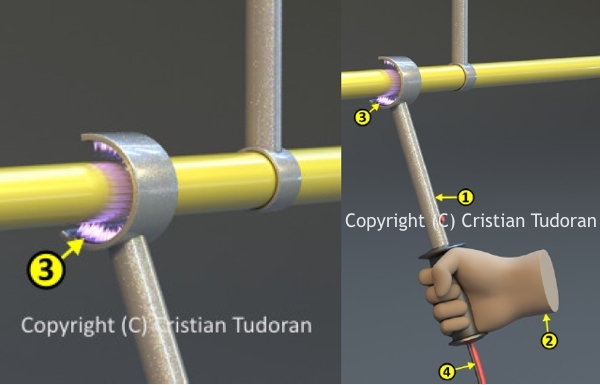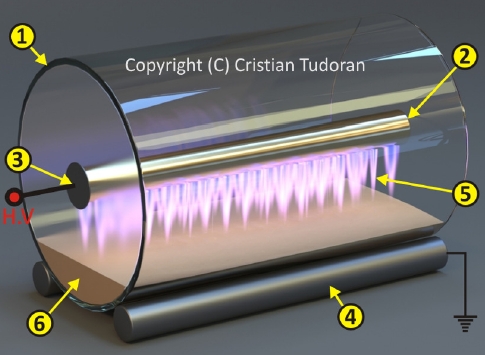General presentation of the project |
| |
 In this project we are assembling a team of skilled young researchers who together will form the In this project we are assembling a team of skilled young researchers who together will form the
first official plasma lab in our institute (INCDTIM) with the main objective to design and
build innovative plasma systems / devices for microorganism inactivation / decontamination,
which will serve humanity.
 Given the current situation on the Planet with this new and freaky coronavirus, we as scientists Given the current situation on the Planet with this new and freaky coronavirus, we as scientists
have to definitely do our best to help with whatever we know and can do, to assist in the global
effort to minimize the effects of this microorganism. This main motivation is doubled by the fact
that most of our beloved ones / relatives were affected at some point by the Covid virus, in one way
or another, either physically, emotionally, socially or economically.
 Cold plasma has entered this field as a novel, highly efficient and clean solution for virus Cold plasma has entered this field as a novel, highly efficient and clean solution for virus
inactivation. Cold atmospheric plasma (also known as open-air nonthermal plasma) operating at
atmospheric pressure and almost room temperature (T<45oC), has been shown to safely and
effectively treat contaminated surfaces and can treat both smooth and rough surfaces.
Among its complex constituents, the emission of UV radiation and reactive oxygen and nitrogen
species have the most important antimicrobial properties. UV photons damage nucleic acids,
whereas the highy reactive molecular species present in the plasma can oxidize the viral nucleic
acids, proteins and lipids. |
|
Very short description of the devices which will be built during this project |
| |
 The automatic hand plasma cleaner/disinfecting system
This device is meant to be installed at the entrances of buildings or in the hallways of schools, public The automatic hand plasma cleaner/disinfecting system
This device is meant to be installed at the entrances of buildings or in the hallways of schools, public
buildings, hospitals, universities, factories, or even in train cars, etc. where people who enter can plasma
clean/disinfect their hands (palms) in a column of cold plasma generated by our patented applicator head
system. The device works in a very simple way: an optical sensor detects when a hand is placed in the
device’s frontal aperture and then the cold plasma is initiated for a duration of about 5 seconds
(the device uses a dielectric barrier plasma discharge, which is supplied by a special high voltage power
supply, isolated from the mains voltage, so, there is NO danger to the user. |
|
| |
 The bus handle bar plasma cleaner/disinfecting device
This device is meant to be used in the preventing disinfection of the handle bars of buses, trains, trams, The bus handle bar plasma cleaner/disinfecting device
This device is meant to be used in the preventing disinfection of the handle bars of buses, trains, trams,
subways, etc. (or other public transport vehicles). An operator passes with the semicircular plasma head (3)
over the lenght of the handle bars, and the plasma inactivates all the surfaces. The device is
portable, and it has a rod shaped handle with an insulating rubber grip for the user’s hand (2). The plasma
head (3) is connected to a Li-Ion powered portable high voltage power source through the cable (4). |
 |
| |
 The floor and wall plasma disinfecting machine
This device is based also on our patented cold plasma applicator head design, and it has an applicator with of The floor and wall plasma disinfecting machine
This device is based also on our patented cold plasma applicator head design, and it has an applicator with of
1000 mm (3). The job of this machine is to „sweep” the floors (A) or the walls (B) with the
cold plasma column in order to inactivate the microorganisms. This device is designed to be used especially
in hospitals, nurseries, etc. The electronics are installed in the main body (1) and the operator works with the
machine from the controlbar (2). |
|
| |
 The rotating plasma drum reactor
This is an experimental cold plasma chemical reactor built specifically for the plasma treatment of nanopowders. The rotating plasma drum reactor
This is an experimental cold plasma chemical reactor built specifically for the plasma treatment of nanopowders.
It is intended to be a „green synthesis” reactor approach to traditional chemical reactions.
As its name says it, the design is based on the principle of the rotating drum reactors. It comprises of an outer
cylindrical or drum shaped sealed enclosure (1) filled with plasma gas (He, Ar, O2, etc.). Inside we have a
coaxially mounted inner electrode (2) which is connected to the high voltage power supply through the
connector (3). This inner electrode (2) is fixed, and the outer enclosure (1) is rotated by an external electric
motor. On the lower side of the drum enclosure (1) we have a metallic electrode (4) which is connected to
the ground terminal of the high voltage power supply. The plasma discharge (5) is initiated between the
lower side of the inner electrode (2) and the grounded electrode (4). Our materials (6) will be placed in the
lower side of the rotating drum enclosure (1), and while the drum will spin around, due to gravity and to
frictional forces, the materials will be tumbled around and completely exposed to the plasma discharge (5).
In this way we are able to plasma treat all the surfaces of our nanostructures, oxidizing or regenerating their
active surface area. Compared to traditional regeneration methods, this plasma reactor can save energy
because it can be operated even at room temperature. Also no solvent will be involved in this process thus
almost no waste will be produced. |
 |
| |
|
